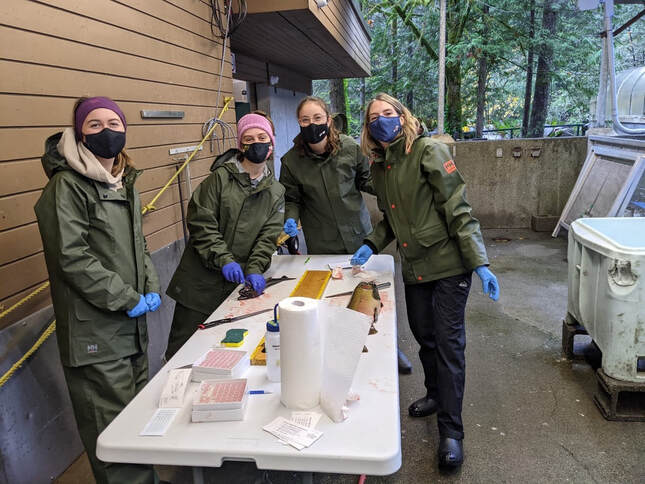A primary function of the hatchery is to raise coho and chum from eggs and release them into various rivers and streams. This adds to the salmon stocks for commercial, recreational and first nations fisheries. But besides producing more fish, the hatchery is involved in various other projects, mostly related to salmon enhancement, but not always. Some projects are simply to improve hatchery facilities so we can maintain current functions and respond to future demands. Other projects are to help improve habitat for all fish, often in collaboration with other organizations. The hatchery also provides an important resource for projects in education and research, which can indirectly enhance salmon stocks well beyond our own rivers and streams.
Some of the projects that Goldstream Hatchery is involved with are described below:
Some of the projects that Goldstream Hatchery is involved with are described below:
MILLSTREAM CREEK FISHWAYS
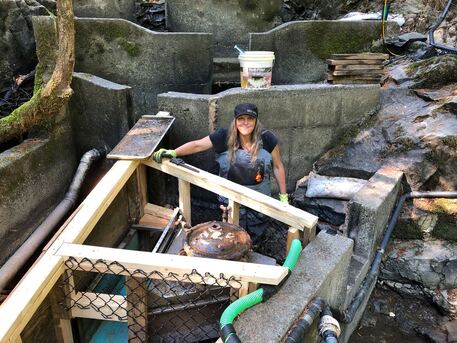 Wendy cleaning up ladder #1
Wendy cleaning up ladder #1
The Millstream Creek watershed was identified as potential habitat for coho salmon in the 1980’s. Although the lower portions of the creek were fairly polluted from surrounding urban development, the upper parts of the stream were fed by small glacial lakes and bogs in a sparsely populated area. There were a number of falls preventing salmon from making their way up the stream to spawn, so the challenge was in finding ways for salmon to bypass these areas to get to the upper reaches of the stream.
Over the following years, several fish ladders (fishways) were built in cooperation with local municipalities and the Peninsula Stream Society. Sources of effluent along the stream were cleaned up. Coho from Goldstream Hatchery were then introduced into the stream in the hopes of eventually establishing a self sustaining salmon population. In 2020, the sixth and final fishway was completed, making the last 7 km of Millstream Creek accessible to spawning salmon.
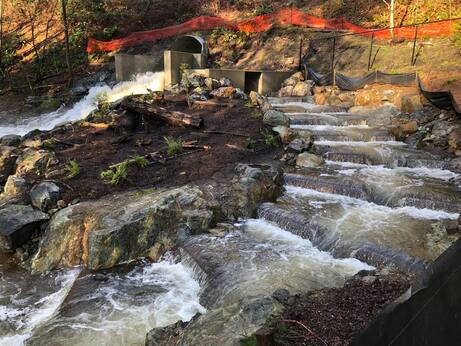 Ladder #6 at Atkins Road
Ladder #6 at Atkins Road
Several volunteers from Goldstream Hatchery have taken on the responsibility of maintaining the fishways. Each year in late summer, the fishways have to be cleared of gravel and debris in preparation for returning salmon. Digital monitoring equipment has to be installed and tested. The volunteers take turns reviewing images of returning salmon and recording type, gender, size and other characteristics. The fishways have also opened up access to the stream for cutthroat trout.
So far, Millstream Creek has been able to establish relatively small but steady coho and cutthroat populations. With the new habitat made accessible by the latest fishway, the hope is that returning numbers will increase significantly and Millstream Creek will become a shining example of how salmon can coexist in an urban area.
For a brief history of how Millstream Creek has evolved, read more here.
So far, Millstream Creek has been able to establish relatively small but steady coho and cutthroat populations. With the new habitat made accessible by the latest fishway, the hope is that returning numbers will increase significantly and Millstream Creek will become a shining example of how salmon can coexist in an urban area.
For a brief history of how Millstream Creek has evolved, read more here.
CAUSES AND CONSEQUENCES OF VATERITIC OTOLITHS IN HATCHERY-REARED COHO SALMON
This project, led by a PhD candidate at UVic, is attempting to identify causes for increased vateritic otoliths in hatchery reared salmon and determine the affect on their survival rates in the wild.
Read more here.
Read more here.
LIFE SKILLS TRAINING AND THE EFFECT OF PREDATOR CONDITIONING ON THE BEHAVIOUR AND POST-RELEASE SURVIVAL OF HATCHERY-REARED COHO SALMON
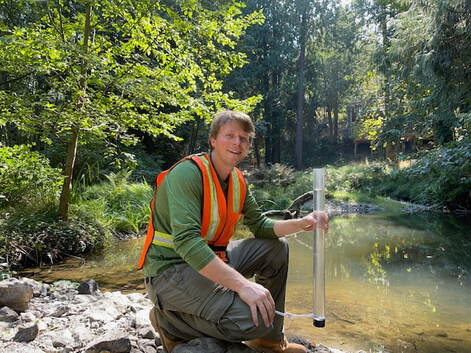 Braeden sampling water on Millstream Creek
Braeden sampling water on Millstream Creek
Wild juvenile salmon are exposed to predators from the time they emerge from their egg. Salmon raised in the hatchery are not exposed to the same dangers before they are released and may succumb to threats that they are not prepared for. This projects attempts to determine the affect of predation on the survival rate of hatchery salmon compared to wild salmon, and identify methods to condition hatchery fish to respond to predators.
Alarm cues are chemicals released from the damaged tissue of fish that may be have been attacked by a predator. These chemicals alert other nearby fish of a potential threat. Several experiments will be conducted using alarm cues and other stimuli in various combinations to determine their effects on juvenile salmon and how they affect salmon survival rates.
This project is being done by a UVic PhD candidate over a 4 year period. Besides monitoring behaviours in the controlled environment at the hatchery, it will also monitor returning salmon in Millstream Creek to determine the effects of predator conditioning on the number of hatchery salmon returning to spawn in a real world environment. The results of this project could significantly improve methods used in raising hatchery salmon and increase the hatcheries ability to supplement wild salmon stocks.
For details about this project, read more here.
THE ROCKY POINT BIRD OBSERVATORY HUMMINGBIRD PROJECT
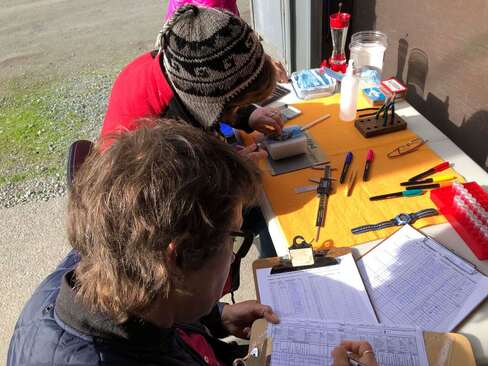 Volunteers record hummingbird data at Goldstream Hatchery
Volunteers record hummingbird data at Goldstream Hatchery
Goldstream Hatchery provides an environment for the Rocky Point Bird Observatory (RPBO) to do research on two species of hummingbirds commonly found in this area. Because of the controlled access to the hatchery, and the daily crew of hatchery volunteers, several hummingbird feeders can be easily maintained and monitored. Members enjoy filling the feeders and watching the antics of these little birds in this isolated habitat. RPBO volunteers visit the hatchery regularly to capture specimens and record data, often with the help of hatchery volunteers. This critical research helps us to understand the environmental factors that affect hummingbird populations.
For detailed information about the RPBO Hummingbird Project, read more here. Check out the Rocky Point Bird Observatory website here.
For detailed information about the RPBO Hummingbird Project, read more here. Check out the Rocky Point Bird Observatory website here.

